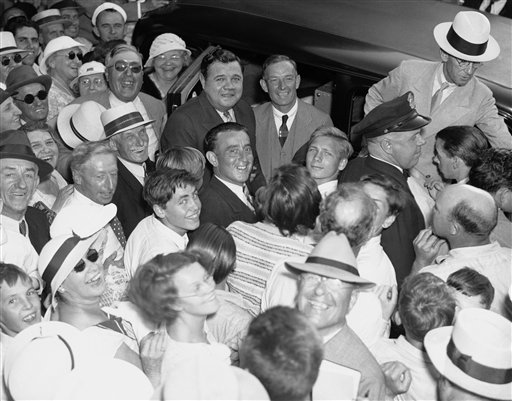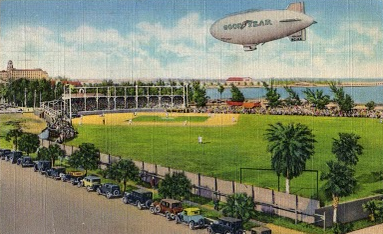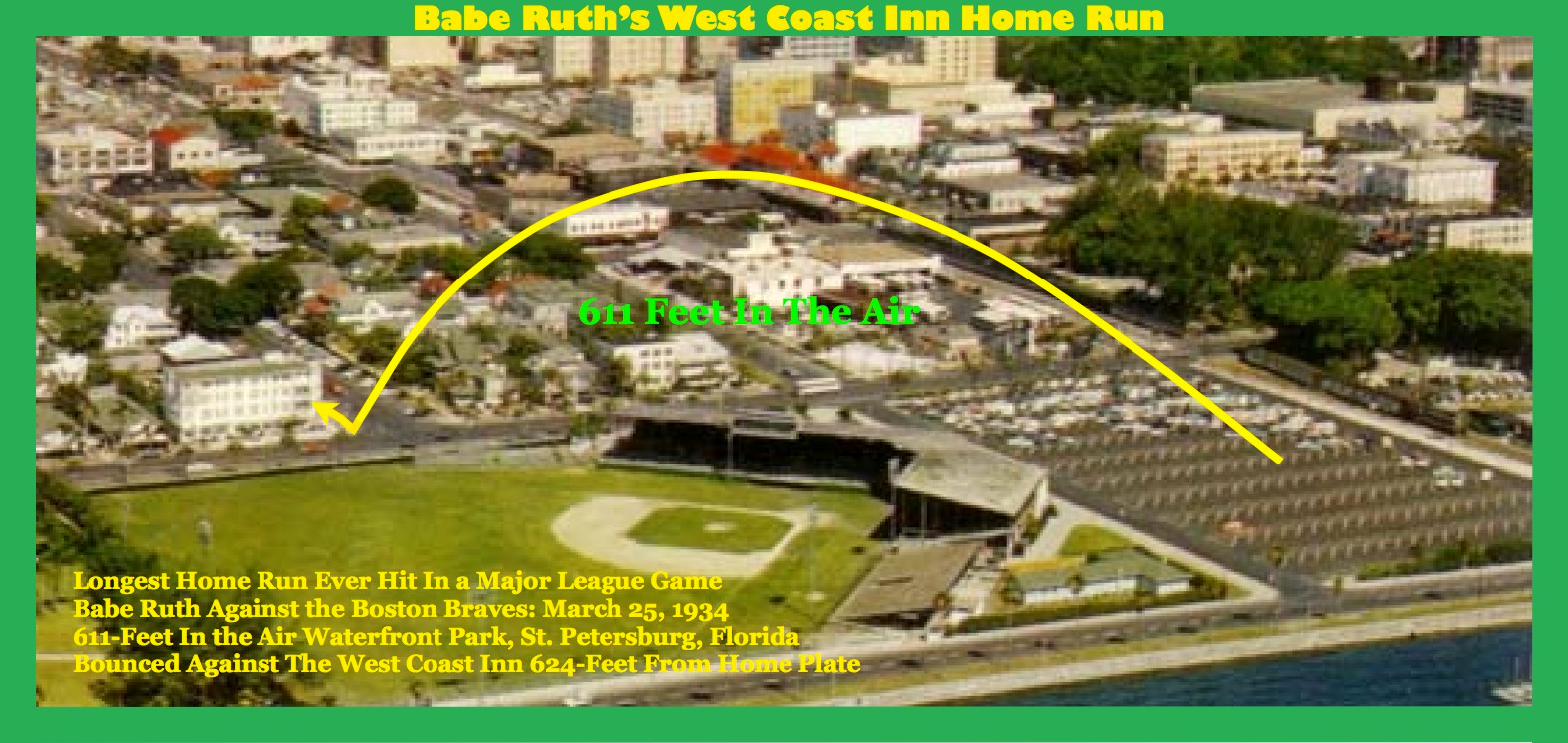The Legend of Babe Ruth’s West Coast Inn Home Run – The Longest Home Run Ever Hit in a Major League Game
Recently, some of BRC’s friends and unofficial research team uncovered a significant treasure of Babe Ruth and baseball-related information – proof that Babe Ruth indeed hit the longest home run ever in a Major League game. Below is a very detailed account of their findings for all baseball and Babe Ruth history buffs to appreciate. A special thanks to Tim, Bruce, Bill and Bob for their efforts in making this great find!
- The West Coast Inn Home Run
In the Spring of 1948, Babe bid his final farewell to Florida, reminiscing with friends, fans & reporters on his “last time around” and how dearly he loved “the Sunshine State”. In each town and ballpark, he was asked about his most treasured memory. In St. Petersburg, his seasonal “home away from home” for many years, he famously recalled what has since become known as the “West Coast Inn Home Run”. This was a reference to a sensationally-long homer he once hit at old Waterfront Park during his decade of Spring Seasons in St. Pete, from 1925 – 1935.
Babe’s Herculean shot to the West Coast Inn was well-known to devoted fans in Florida. As Pete Gallagher of the St. Petersburg Times described it decades later, it was the “Sunshine City’s” “Shot Heard Around the World”. But not until after Babe’s death was it known to the nation, when the preeminent sportswriter of that era, Red Smith, featured the historic home run in a poignant tribute to the King of Clout following his funeral later that year:
“What do you most remember best about this place, Babe?” … “The time I hit that [colorfully-described] ball against that [colorfully-described] hotel.”
Simultaneously, Babe pointed beyond the fence in right-center, at the distinctly-ornate West Coast Inn, where the Boston Braves lodged for many Spring Seasons – aka the “Home of the Braves”.
Though never forgotten among local historians and fans of baseball, the actual date and circumstances of Babe’s astonishing feat eventually became regarded more as myth than fact as years and witnesses passed one by one.
Also obscuring evidence was the 1947 replacement of Waterfront Park with Al Lang Field – “The Other House That Ruth Built” – leaving significant landmarks and distances uncertain to the general populous. Most fortuitously, however, there were devout baseball fans who happened to work for the City of St. Petersburg Survey Office, located only a short walking distance from these sites in subsequent decades. This fact helped not only in the generational re-verification and communication of valuable anecdotal evidence, but, even more importantly in connection to researching the West Coast Inn Home Run, the authoritative affixing of a professionally-precise distance for this truly landmark home run. City surveyors knew it to be a jaw-dropping distance of “between 610- and 612-feet”!
How could this distance be known with such precision? Because Babe actually hit the second-floor porch of the West Coast Inn, with the sphere first bouncing (on a fly) on its front walkway, which, at its closest point, was 610-feet from where Babe smashed his phenomenal “four-bagger”. Though the hotel itself was a few inches short of 624-feet from home plate, “erring on the side of caution” has led over time to an estimated distance of 611-feet. It could have been a few feet more.
…Enter Floridian cousins and best friends, Bob Ward & Tim Reid, long-time fans of Babe, who founded and co-direct the national Committee to Commemorate Babe Ruth. In the 1970’s, both worked for the City of St. Petersburg, Department of Engineering, where they were often regaled by City surveying officials with a wealth of well-informed accounts of Babe’s amazing times and achievements in St. Pete, including, most notably here, the story of what Ward & Reid have since coined “Babe Ruth’s West Coast Inn Home Run”. These accounts were a primary inspiration leading to the 2009 founding of the Committee to Commemorate Babe Ruth.
Determined to establish whether this often now-regarded only mythical home run ever really happened, as old timers had insisted for more than half-a-century, Ward & Reid teamed together with the “Babe Ruth of Babe Ruth historians”, Bill Jenkinson, and long distance home run researcher and graphic artist, Bruce Orser, forming what the Committee calls the “St. Pete Babe Ruth Research Team”. Together, this four-man team has methodically unraveled the mystery of the formerly mythical home run. “Formerly mythical” because – following and building upon a key discovery by Bruce Orser this summer – it has now been expertly and positively confirmed that Babe Babe did indeed hit the West Coast Inn. Not only that, it can be now be said he did it in a hotly-contested Major League Game, during Babe’s last Spring Season in Yankee pinstripes – on the afternoon of Sunday, March 25, 1934.
This new evidence came to the research team in the form of a long-unseen article in the Boston Herald, which described the event as a “towering”, “10,000 League” “circuit clout”. Though many other newspapers reported the home run in glowing terms, they did not specifically reference the West Coast Inn by name. Because Babe hit so many prodigious shots in St. Pete – in Major League games, unofficial exhibitions and batting practice – and because he had hit shots against several other hotels and structures on numerous occasions – it has been previously impossible to identify with concrete evidence exactly which one of these home runs (if any) had hit the West Coast Inn during a Major League game. This was so, even with a very credible first-hand witness statement from resident Mike Mastry, who, as a teenager, saw all of Babe Ruth’s Spring games and homers in 1933 & 1934, and unambiguously attested that one of those home runs had definitely hit the West Coast Inn. He was unable, however, to specify an exact date, which precluded the home run’s positive identification.
One of the initially surprising features of this story is that Babe performed this Ruthian feat so late in his career, at the age of 39, very soon to be the oldest active player in the league, after Rabbit Maranville broke his leg in a subsequent game that Spring. Research reveals several reasons that help explain this. First and foremost, Ruth hit with extreme power throughout his career, out-slugging even the mighty and much younger Jimmie Foxx in Major League Baseball’s tour of Japan later that year, and even still on occasion in Babe’s abbreviated last season of 1935.
But there were other factors that may well have been at work in the Spring of 1934. These include: Babe’s being in very good spirits and physical shape; his unprecedented early acceptance of the Yankees pay offer that Spring and thus his joining camp on the first day of training; a new practice regime which alloted him far more time for batting practice than in previous years; a lighter (36-oz) bat, new grip and modified swing; and a visibly enhanced sense of focus and purpose, with the aim and hope of playing beyond his one-year 1934 contract, into 1935. There is also a report that the Yanks received a possibly “prehistoric” jawbone dug up by a local boy- one that both Ruth and Gehrig considered extremely effective in the rubbing down of their warclubs.
In fact, most of the Yankee sluggers were slamming the ball hard and long in the Spring of 1935, but none nearly as incredibly far and phenomenally as the rejuvenated Sultan of Swat. Measured in terms of batting production, it proved to be his most profoundly powerful Spring Season ever. And he played some great golf, too, highlighted by a couple of notable tournament victories, and the only double-eagle in the history of the Jungle Club.
And so it is that Baseball historians and fans can now confidently assert that the longest ball ever hit in a Major League Game was hit by Babe Ruth – on the afternoon of Sunday, March 25, 1934 – when he hit the old West Coast Inn, in St. Petersburg, Florida. Waxing poetic in the style of the old Baseball scribes, it could be said to be “Florida’s First Moonshot”.
Endnotes: No one hit nearly as many historically long home runs as Babe. His longest home run in an MLB Regular Season is estimated at between 575 and 600 feet, against Ty Cobb’s Tigers, in July of 1921. His longest home runs in exhibition games against amateur pitching are believed to be those he hit in Wilkes-Barre, Pennsylvania (in October of 1926) and Dunsmuir, California (in October of 1924), both estimated to have been over 600-feet. In batting practice and multiple intra-squad Spring Training games in St. Petersburg, Babe splashed dozens of balls into Crescent Lake, where the Yanks trained from 1925 to 1934. He is the only player known to have reached the lake, which ranges, at its closest point, from 500-feet to 600-feet from that park’s home plate. Across Tampa Bay, in 1919, he hit an astounding home run that was approximately 560-feet. And in Hot Springs, Arkansas, he hit one about 570-feet in 1918.
Finally, in a news report immediately following the West Coast Inn Home Run, a major local sports reporter reported that, in the reporter’s estimation, Babe had actually hit one longer in St. Pete – in a game “eight or nine years earlier”, “over the flag pole atop the centerfield fence.” …. Oh, Babe! – So, it looks as though the St. Pete Babe Ruth Research Team has even further research to do!


